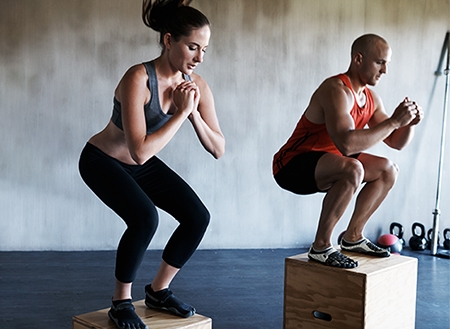March, and hopefully Spring, are upon us! This tends to be the time of the year when folks lose sight of their New Year’s resolutions, especially if the weather is still rather cold and dreary. New exercise habits can be difficult to maintain while being stuck indoors day after day. Sometimes, cross-training can be all you need to bust that rut and get back on track!
Have you ever thought that you were in great physical shape only to be proven incorrect by a weekend of recreational activity that leaves you immeasurably sore in muscles you didn’t even know existed? Cross-training can help prevent, or at least minimize, those excruciating days to follow. Cross-training means performing movements or activities that differ from your normal routine. It is not just a matter of alternating upper body and lower body strengthening days. In addition to strengthening different muscle groups, incorporating varied activity is important. If you enjoy lifting weights, it is important to also include cardiovascular activity as well as stretching and flexibility exercises into your regimen. If you are a cardio junkie of sorts, remembering to also strengthen the muscles will help avoid repetitive use injuries. Not only is cross-training a great way to stay interested in your exercise routine, but it has also been proven to actually maximize your results and help you reach your overall fitness goals. Performing the same movements over and over again often causes the body to plateau.
Cross-training is equally as beneficial, if not more so, for youth athletes. In a culture of frequent sport specialization at an early age, incorporating some varied activity into a training program does not, in fact, detract from specialty training. Rather, it helps with injury prevention by developing greater general athleticism and reducing the risk of overuse injuries. Throwing athletes need to work their non-dominant arms. Swimmers need to balance all of the swimming with back strengthening exercises and land activity. Runners need to strengthen and stretch all of their muscles and work in lateral planes to improve agility.
Cross-training doesn’t have to be challenging. It can be as simple as shelving the dumb bells and reaching for the resistance bands one day or swapping the treadmill for the stationary bike. Some people choose to get creative and try rollerblading or a new fitness class like Zumba or aqua aerobics. Whatever your resources (or the weather) allows, the results are worth it. Failing to cross-train appropriately can lead to injuries such as stress fractures, muscle strains, and neck and back injuries. A thoughtful activity regimen is often all it takes to avoid these types of injuries. However, if you do find yourself plagued by one of these issues, give Orthopaedic Associates of Wisconsin a call and let one of our board-certified specialists develop a treatment plan to help get your fitness goals back on track!
This blog is written by one of our very own-Morgan. She is a certified athletic trainer working in our clinic with our providers each and every day. She obtained a bachelor's degree in athletic training from Carroll University in Waukesha and a master's degree in Kinesiology from Michigan State University.

